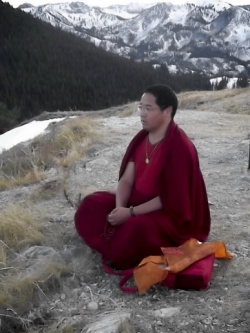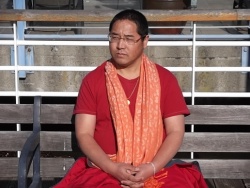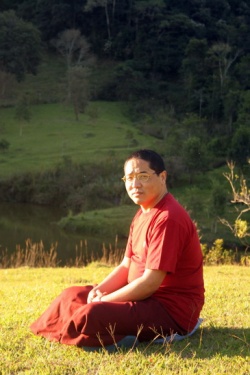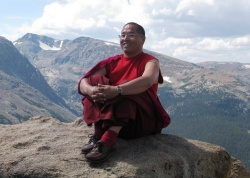Ven. Lopon Osels Biography
In The Tantra of the Union of Sun and Moon:
If you do not explain the history of its origins
People will commit the fault of not believing
In the profoundly secret true teaching.
Lopon Osel gyurme was born in the village of Mugom district, a region of eastern Nepal at the south face of the Himalayas. His Grandfather was an accomplished Dharma Practitioner who spent so much time in retreat his hair was thoroughly matted and his mind pure. He built a mountain hermitage where Lopon Osel’s father is currently engaging in retreat. His Grandfather’s teacher was Drubwang Tenzin Dargye who was known to hang his clothes on sunbeams and make water appear in the high mountain ranges during the winter. During their special practice sessions for the new year, his grandfather always made aspirations and dedications for the nonbuddhist countries.
It is Lopon Osel’s hope to bring benefit to beings in countries where Buddhism was once unknown and bring to fruition the virtuous prayers he heard as a child. Now that he is in the West Lopon Osel particularly remembers these prayers made during the Tibetan New Year. In his analysis his grandfather’s prayers have resulted in his karma playing out in the West.
Lopon Osel’s father, Guru Tenzin, a Lama with many years spent in retreat, and his mother, Sherab Lhamo, followed their ancestors in deep devotion to many masters of Buddha Dharma. The family has its roots in Toe in western Tibet. His father was a student of Buddhism under His Holiness Dudjom Rinpoche, Kybje Dilgo Khyentse Rinpoche and His Eminence Serta Rinpoche. His father is a practitioner of the Dudjom Terma and Rigdzin Jetson Nyingpo Terma.
As a child of around seven or eight years old, Lopon Osel’s sister came from Kathmandu, telling stories of a Great Lama that she had met to her mother. This teacher was Dilgo Khyentse Rinpoche. when Lopon Osel heard his name the hairs in his pores stood on end. He later became a student of Kyabje Khyentse and has always considered Him to be his Guru.
Nagarjuna said: If someone were to fall from the peak of the king of all mountains, although this may seem impossible for the mind to comprehend, it could still occur. If through the Lama’s kindness, a beneficial teaching is received, Even if liberation is not desired, it could still occur.
Lopon Osel had a profound interest in Dharma study, but his families plans were to have him working in family activity and to marry. But eventually at Lopon Osel got the permission of his family to become a monk– and was very happy to study the Dharma. At around nine years old, he dedicated himself to the study of the Tibetan grammar with his father. At the age of fifteen,
Lopon Osel entered the Shechen Monastery commencing his education of formal Buddhist studies under the direction of Kybje Dilgo Khyentse Rinpoche. For many years, Lopon Osel focused his studies on Tibetan grammar along with Buddhist Rituals. At nineteen, Lopon Osel was admitted into the Monastic University of Shechen for Advance Buddhist Studies. Here he studied logic, philosophy, Madyamika, Bodhicharyavatara, the Abhidharma, Vinaya etc.
Lopon Osel studied all major texts of the Nyingma Lineage. He received teachings and transmissions directly from Kyabje Dilgo Khyentse Rinpoche on the Nyingma and other Tibetan traditions.
Lopon Osel served as an Assistant Professor of the University for six years beginning in 1994. In 2000, Lopon Osel received the title of Master from Kabyje Shechen Rabjam Rinpoche. At the request of the Shechen Monastery, Lopon Osel assumed responsibility of teaching the monks. He taught classical texts including Mahayana and Vajrayana teachings.
Lopon Osel continued to instruct these students on the teachings and oral transmission lineages of his teachers.
Je Gotsangpa said: “Even though there are many developing stage visualizations,
None is higher than visualizing the Lama. Even though there are many completion stage meditations,
None is more reliable or all-encompassing than meditating on the Lama.”
Lopon Osel’s primary teachers include: Kybjé Khyentse Rinpoche, his root guru from which he received sutra and tantra teachings, empowerments, and oral transmissions; Kyabjé Trulshik Rinpoche, who taught many different terama and kama from four traditions; and the Dudjom Tergsar empowerment;
Kybjé Minling Trichen Rinpoche, who gave oral transmissions; Kyabjé Penor Rinpoche who taught RinchenTerzod Chenmo, which is the complete collection of Nyingma Pa tradition Terama;
Kybjé Taklung, Tsetrul Rinpoche, who taught the Chang Ter tradition and oral transmission; Shechen Rabjam Rinpoche, who gave many transmissions and taught several texts;
Kybje Dungse Rinpoche, from whom Lopon Osel received the profound instructions, empowerments and teachings.
and Khenpo Pentse,Rinpoche who gave the Guriagarba teaching;
Khen chen Pema Sherab, teachings of Buddhist philosophy, and many other great and kinds teachers.
Lopon Osel says, “All my teachers were truly Avalokitesvara and Guru Rinpoche Resting in the Nature of Mind Himself, and took on the form of a spiritual friend. For those who can practice and pray my teacher is really a Perfect Buddha.
I do not say so just because I want to praise or honor him. He really is the Great Perfect Vajradhara, come to benefit beings in an ordinary human form. And as for me, ever since I first met him I have done everything served him of my life and have never done anything to displease him for one instant or even
to make him frown.
So you can be sure that there has been absolutely no degradation of samaya to tarnish the golden chain of this lineage. The result of my learning and practicing for many years has been a humbling process of my superficial and egotistical tendencies. For me practice is a constant purification of myself and other sentient beings and I confidently wish to attain Ultimate Enlightenment.”
Lopon Osel lived at the Shechen Monastery continuously for nineteen years. He attended the University at Shechen Monastery (Shechen Institute for Advanced Studies of Nyingmapa Buddhist Philosophy) for eleven years.
At the Shechen Monastery, Lopon Osel passed his time listening to, contemplating on, and meditating on the teachings, and in addition, His lif mors times doing retreat. Many people from his town would come to visit him at the Shechen Monastery seeking advice and counsel. He also became a highly sought out counselor to the many western visitors to the Shechen Monastery.
In all situations, he holds in his heart “I pray that my activities benefit of all sentient beings, that I remain in the Supreme Vehicle -The Vajrayana and its Supreme Practice- Guru Yoga, so that I may accomplish the aspirations of my teachers.”
In the Tantra of All-Containing Jewels, it says:“No matter who practices for one hundred thousand eons By meditating one hundred thousand deities, Just remembering the Lama is supreme. The merit of this is limitless. More than practicing and reciting a million mantras, Praying once to the Lama is supreme.” His selfless and compassionate service as teacher,
advisor, and counselor continues in Brazil, the United States, and throughout the world as he spreads the Buddha-Dharma for the benefit of all sentient beings and to honor all the great teachers of the Dharma.
Lopon Osel’s Activities in theUnited States In the United States, where Tibetan Buddhism is not prominent,
Lopon Osel wishes to devote his time to providing instruction in Vajrayana practice and philosophy. During his time in Salt Lake City and the United States, Lopon Osel spends his time giving teachings, initiations, and oral transmissions including the Terma of the Nyingma Lineage, the extensive commentaries, and the sadhanas always with the aspiration to benefit all sentient beings and ultimately establish them in
Enlightenment.
The following is from an interview with the Lopon Osel How can one find happiness?
Lopon Osel: Buddha said even the smallest beings want to have happiness. In fact, all beings are looking for happiness. This is the wish that abides in everyone’s mind: To have happiness. But we do not really know what to do. This is why, even when we have the intention to attain happiness, we many times engage in wrong activities such as stealing, killing, and lying. Even if in our mind our final objective is to be happy,
even if we have the idea of happiness, we do negative and harmful actions to other beings and ourselves with our body and speech This happens because we do know about cause and effect. We can begin to understand cause and effect by observing nature: When you plant a rice seed, for example,
what finally grows is always rice. This is the effect. Have you ever seen a potato plant come from a rice seed? In Buddhism, we give this relationship between cause and effect, the name karma. Karma can be positive or negative depending on our actions. How much more negative karma, the greater you will experience suffering. How much greater positive karma, the greater is your happiness.
We speak of two kinds of interdependence: external interdependence and internal interdependence. External interdependence corresponds to exterior aspects, like the example we just mentioned with the rice seed. Internal interdependence is inside your mind.
Buddhism call the five poisonous thoughts: anger, desire, ignorance, pride, and jealousy. It is these poisonous thoughts that are the cause of our suffering, and also [the condition of] others suffering.
We do not understand this. Further, all the luminous qualities we have in our minds come from the correct motivation to help other beings through love, compassion and patience. These are in reality the seeds of our happiness as well as [the condition of] others happiness.Should a person live their life constantly fighting and creating confusion,
others around them do not want to be close because they will also suffer. On the other hand, if a person promotes love and happiness, everyone wants to be close to them. Others feel comfortable and know that with them they need not be afraid. Unfortunately, with our habitual tendencies acquired over many lives, we easily commit negative actions.





